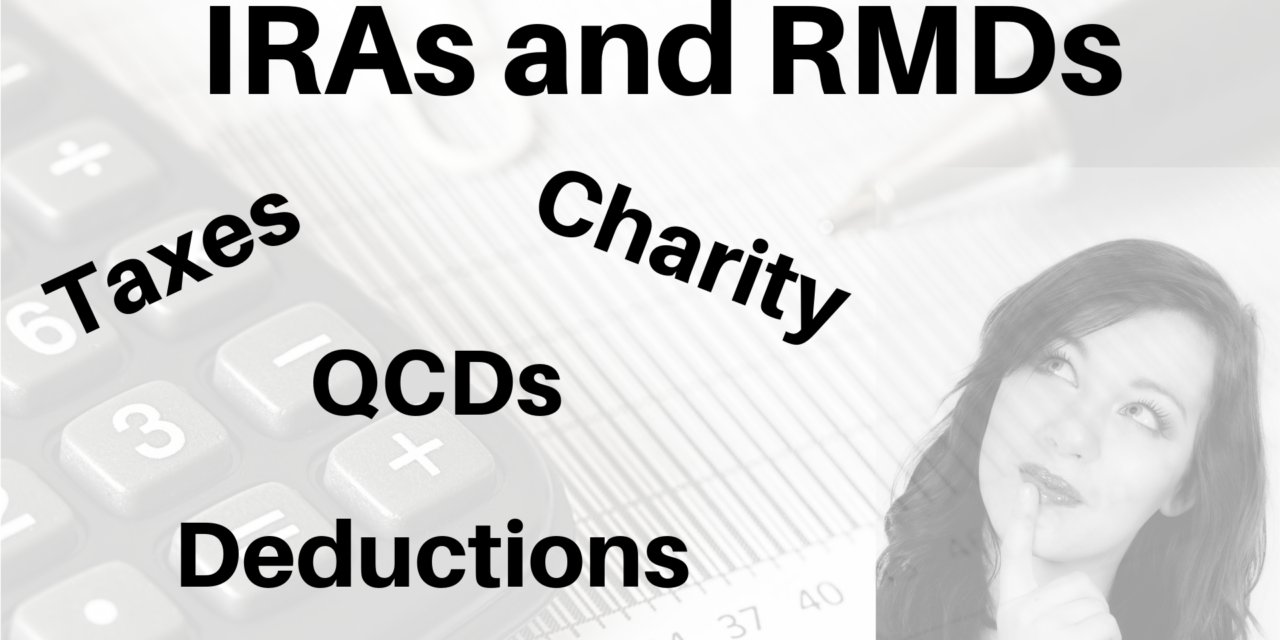(Updated 11/9/2022)
You saved for years into your Individual Retirement Account and never paid a penny of tax on the money, provided you made no withdrawals. That was a sweet deal, allowing you to benefit from the powers of compounding and tax deferral.
But once you turn 72, it’s time to start paying the piper, or more precisely, the tax man. At that age, the IRS requires you to begin making annual Required Minimum Distributions, or RMDs, from tax-deferred retirement savings accounts. Every dollar of the RMD is taxable income.
Depending on the amount of the IRA withdrawal, where you live, and your specific tax situation, the RMD could push you into a higher tax bracket, raise the amount of tax due on your Social Security income, and be subject to state tax.
Would you like to avoid this extra tax burden? There’s a simple solution: Give the RMD to charity.
Taxpayers age 70 ½ and over may donate up to $100,000 each year from their IRA to qualified nonprofits. This donation can include the RMD amount. Donating the RMD money (or more) to charity keeps it out of your taxable adjusted gross income.
Giving money from your IRA to charity is called a Qualified Charitable Distribution, or QCD. It’s a tax strategy you should consider, especially if you already make charitable donations each year.
Who May I Donate To?
The charitable recipient for your QCD donation may include your church or other places of worship, the university you attended, well-known national charities, and thousands of local charities recognized as 501(c)(3) nonprofits by the IRS. Note that donations made to private foundations and donor-advised funds (DAFs) do not qualify for this benefit.
This strategy makes even more sense today because far fewer American taxpayers can itemize their deductions, including charitable donations. This is a result of the Tax Cuts and Jobs Act of 2017, the most sweeping tax reform in a generation. Standard deductions nearly doubled, making it harder for the average taxpayer to benefit from itemized deductions. For the 2022 tax year, the standard deduction for single filers is $12,950 and for married couples filing jointly it is $25,900. For taxpayers, age 65 and over, single or head-of-household filers get an additional $1,750 standard deduction and married couples filing jointly get a $1,400 increase for each spouse 65 or older. In other words, the standard deduction for 2022 for a single taxpayer over age 65 is $14,700 and for a married couple filing jointly, both age 65 or over, it is $28,700.
How a QCD Benefits Jack & Rosa
To illustrate how the IRA Qualified Charitable Distribution rule can help, let’s look at a hypothetical retired couple. Jack and Rosa usually give $10,000 per year to their church and other qualified nonprofits (charities). Before tax reform, they itemized their deductions and got a nice tax benefit from their charitable giving. Even if getting a tax break wasn’t their primary motivation for giving, it was a nice perk. Thanks to the higher standard deduction of $28,700 (Jack and Rosa are both over age 65), they can no longer benefit from itemizing when filing their federal tax return unless they have an unusually large number of other deductions.
Since Jack recently turned 72, he is required to withdraw $12,000 from his IRA to meet the RMD rule. To benefit from the QCD opportunity, they may now want to take their charitable gifts from Jack’s IRA account, rather than donating by cash or check as they have done previously. The $10,000 in donations to their church and other charities through the IRA won’t count on the tax return as a tax deduction, but that doesn’t matter, since they no longer itemize. Even so, the couple reduces their total income tax by only having to add $2,000 to their adjusted gross income from the RMD withdrawal, not the entire $12,000, thanks to the charitable donations from Jack’s IRA.
And remember, you aren’t limited to only donating the amount of your RMD to charity. Senior adults age 70 1/2 and older may donate up to $100,000 annually from their IRA accounts, avoiding the tax burden that would otherwise occur. Using the illustration above, Jack and Rosa may decide they want to give more money to charity this year. They give $15,000 rather than their usual $10,000, taking all of it from Jack’s IRA and not having to write a single check to charity all year. Now, all of Jack’s RMD is fully covered by this QCD charitable giving and no income tax will be due on his RMD withdrawal from his IRA.
Interested in taking a QCD from your IRA?
Contact your IRA custodian. Most of them will have a ready-made form for you to complete. It’s an easy process. You’ll just need to know the amount you wish to withdraw from your IRA and the name and address of the charity (or charities) you wish to receive your donation. Keep a copy of your completed form and the receipt from the charity for proof for tax purposes.
For more information, please see the IRA Publication 590-B for the most current tax year.
One warning:
To qualify as a QCD, the IRA withdrawal must be made in the name of the charity and mailed directly to them. You cannot withdraw money from your IRA in your name and then decide to sign it over to charity. Do not take constructive receipt of the IRA withdrawal yourself.
Before taking action on this or other educational articles, it’s always a good idea to discuss it first with your tax advisor or financial planner.
Q&A on Rules for IRA RMDs and QCDs
Definitions:
IRA = Individual Retirement Account
RMD = Required Minimum Distribution
QCD = Qualified Charitable Distribution
Q: Who must take RMD withdrawals?
A: Anyone age 72 or older with a balance in a traditional IRA or other tax-deferred retirement accounts.
Q: How much must I withdraw?
A: The percentage is based on age and increases each year, based on IRS actuarial tables. In the first year, when a person turns 72 the RMD percentage is currently about 3.9 percent of the total value of all of your IRAs. You can calculate your own RMD results using the IRS’s IRA Required Minimum Distribution Worksheet.
Q: What happens if I fail to take an RMD withdrawal?
A: You will face a 50 percent tax penalty, plus you must still make the required distribution and pay the normal amount of tax on it.
Q: Do I have to take RMD withdrawals from my ROTH IRA?
A: No, ROTH IRAs are not subject to RMD rules, since the money is not taxable when withdrawn.
Q: How much may I donate each year to my choice of charities or faith-based institutions using Qualified Charitable Donations (QCD) from my IRA?
A: If you are 70 1/2 or older, you may donate up to $100,000 annually from your IRAs to charity and avoid counting these donations as taxable income.
Q: I have three IRAs. May I donate up to $100,000 annually to charity from each of them?
A: No, the $100,000 cap is applied cumulatively to all of your IRAs taken together. You may choose which IRA account to make the QCD from, or take some from each IRA as long as the grand total does not exceed $100,000.
Q: May I request a withdrawal check from my IRA administrator and then write a check to charity after receiving that money?
A: No, that will not count as a QCD. You must instruct your IRA administrator to make the donation directly from your IRA account to the charity.
Q: I’m 67. Why can’t I make a QCD withdrawal from my IRA to charity and reap these tax benefits?
A: Sorry, you’ll have to argue that with the IRS. You must be 70 1/2 or older to benefit from this strategy. Who said getting older doesn’t have some benefits?
We hope you found this article helpful. Sign up below and never miss another post from This Retirement Life.
This article is for information purposes only and should not be considered as specific tax, legal or investment advice. Before acting on this information, first consult with your tax or other professional advisors.
copyright 2018-2022 by This Retirement Life









i would like to donate to the country abroad, e.g. Japanese charitable organization from QCD.
Is it possible? If so how do I go about it?
That’s an interesting question. My initial answer is probably not, since the charity would need to be recognized by the IRS as a 501(c)3 charity. However, that would be a good question to ask your tax adviser. Best wishes to you.
Neither my bank, tax preparer, nor receiving charity have done a QCD before. Could you tell me what IRS forms each of them will need to use ? I want to be able to check they do it properly. And do I need to do anything else, other then tell them what I want done?
Typically your IRA custodian, which in this case I assume is your bank, will have a ready-made form to complete to request taking a Qualified Charitable Deduction (QCD) withdrawal from your IRA. You might ask your bank if they are using another company as the custodian or administrator for their IRAs. If so, you or the banker can contact them to request their form. If this fails, you should be able to make a written, signed request to your bank to withdraw X amount of money from your IRA for purposes of declaring the withdrawal as a QCD. The letter should include the name and address of the charity (or charities) you want to receive the donation. In your letter, instruct the bank that the withdrawal check should be written to the IRA custodian and not to you, and ask the bank to please send it. Be sure to include your IRA account number too. Keep a copy of the letter for tax purposes. It’s important that the check NOT be made in your name. This should work fine, but it’s always a good idea to share this response with your tax preparer to make sure he/she agrees.